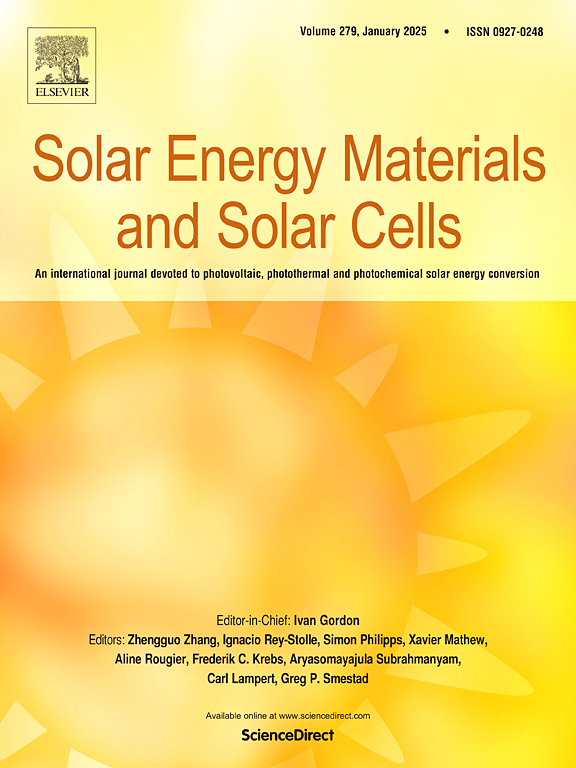Experimental performance investigation on a gold nanofluid laden spectral beam splitting photovoltaic /thermal system under tropical climate of India
IF 6.3
2区 材料科学
Q2 ENERGY & FUELS
引用次数: 0
Abstract
In last two decades, a significant performance enhancement of nanofluid-based spectral beam splitting photovoltaic/thermal (SBS-PV/T) system has been reported. However, the studies reported so far, related to nanofluids (as spectral beam splitter) in SBS-PV/T systems, is limited to either laboratory scale experimental testing or simulation work. Further, a handful studies are available in literature to evaluate the thermal performance of these hybrid systems with full-scale prototype over several days of outdoor experiments. Considering that, the present study analyzed real-time performance characteristics of a full-scale nanofluid laden SBS-PV/T system under outdoor condition in tropical climate of India. The study utilised chemically synthesized gold nanoparticles (Au-NPs) of sizes∼20–25 nm, to prepare Au plasmonic nanofluids at different mass concentrations. Localized Surface Plasmon Resonance (LSPR) peak of Au-NPs appears at 523 nm, well within the visible region. The outdoor testing revealed a maximum temperature rise of about 66 °C in the nanofluid channel with Au plasmonic nanofluids at mass fraction of 0.0004 wt%, which is about 6 °C higher than DI water under similar operating conditions. Moreover, PV modules with Au plasmonic nanofluids experienced lower surface average temperature as compared to the standalone PV system (i.e., 54 °C against 62 °C). Further, overall thermal efficiency of SBS-PV/T system was about 7 % higher with Au plasmonic nanofluids at mass concentration of 0.0004 wt% over DI water. The study concludes that SBS-PV/T systems, particularly those employing real-time monitoring, hold significant promise for its commercialization.
印度热带气候条件下含金纳米流体分光光热系统的实验性能研究
在过去的二十年里,基于纳米流体的光谱分束光伏/热(SBS-PV/T)系统的性能得到了显著的提高。然而,目前报道的有关纳米流体(如光谱分束器)在SBS-PV/T系统中的研究仅限于实验室规模的实验测试或模拟工作。此外,文献中有一些研究可以通过几天的户外实验来评估这些混合系统的全尺寸原型的热性能。因此,本研究分析了印度热带气候下全尺寸纳米流体负载SBS-PV/T系统在室外条件下的实时性能特征。该研究利用化学合成的尺寸为~ 20-25 nm的金纳米颗粒(Au- nps)来制备不同质量浓度的金等离子体纳米流体。Au-NPs的局部表面等离子体共振(LSPR)峰出现在523 nm处,完全在可见光区域内。室外测试表明,金等离子体纳米流体质量分数为0.0004 wt%时,纳米流体通道的最高温升约为66℃,比同等操作条件下的去离子水高约6℃。此外,与独立PV系统相比,具有Au等离子体纳米流体的PV组件的表面平均温度更低(即54°C对62°C)。此外,当金等离子体纳米流体质量浓度为0.0004 wt%时,SBS-PV/T系统的整体热效率比去离子水高约7%。该研究的结论是,SBS-PV/T系统,特别是那些采用实时监测的系统,在商业化方面具有重大前景。
本文章由计算机程序翻译,如有差异,请以英文原文为准。
求助全文
约1分钟内获得全文
求助全文
来源期刊

Solar Energy Materials and Solar Cells
工程技术-材料科学:综合
CiteScore
12.60
自引率
11.60%
发文量
513
审稿时长
47 days
期刊介绍:
Solar Energy Materials & Solar Cells is intended as a vehicle for the dissemination of research results on materials science and technology related to photovoltaic, photothermal and photoelectrochemical solar energy conversion. Materials science is taken in the broadest possible sense and encompasses physics, chemistry, optics, materials fabrication and analysis for all types of materials.
 求助内容:
求助内容: 应助结果提醒方式:
应助结果提醒方式:


